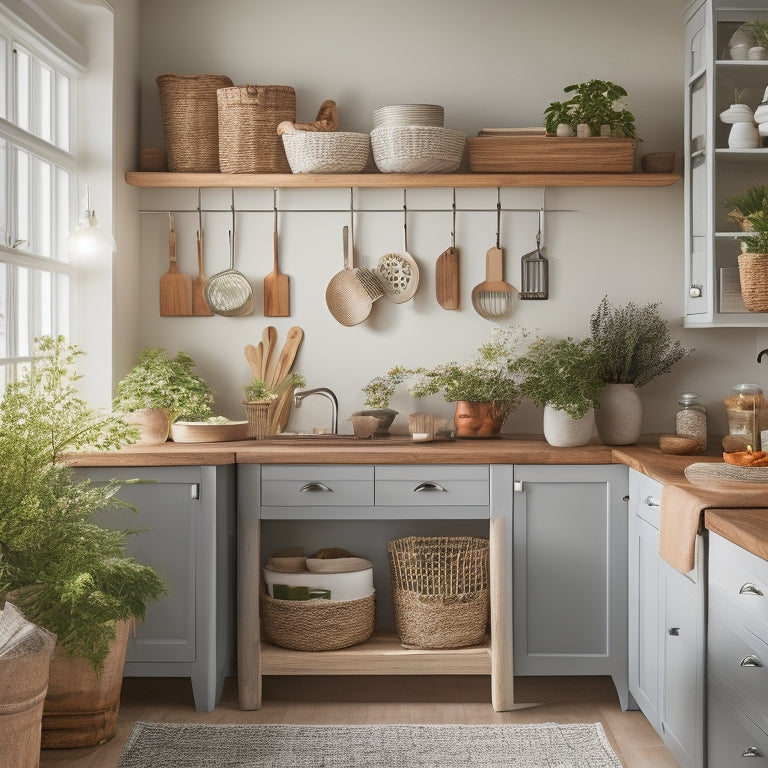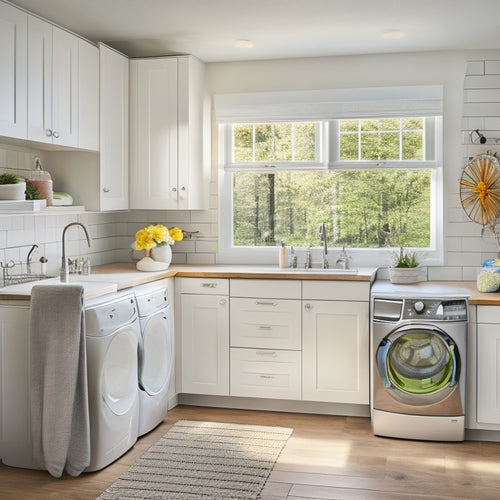
3 Best Practices for a Clutter-Free Kitchen
Share
To achieve a clutter-free kitchen, start by purging unnecessary items, sorting them into keep, donate/sell, and discard piles. Be honest about each item's usage and let go of emotional attachments. Next, designate a home for everything, categorizing items into zones and assigning specific storage spaces. Finally, develop a clean-as-you-go habit by wiping down countertops, sweeping floors, and tidying up after each meal. By implementing these three best practices, you'll be well on your way to a stress-free kitchen. But what happens when you put it all together?
Key Takeaways
• Purge unnecessary kitchen items by sorting them into keep, donate/sell, and discard piles, being honest about each item's usage.
• Designate a specific home for each item, categorizing them into zones and creating station setups for easy identification and workflow.
• Establish a 'clean as you go' habit by wiping down countertops, sweeping floors, and setting a timer for post-meal tidy-ups.
• Create a sense of order and harmony by designating homes for frequently used items, improving kitchen workflow, and making cleaning a sustainable habit.
• Implement best practices for organization, enhancing kitchen functionality, and promoting efficiency in meal preparation to achieve a clutter-free kitchen.
Purge Unnecessary Kitchen Items
Start by clearing everything out of your kitchen cabinets, drawers, and countertops, and sort items into three piles: keep, donate/sell, and discard. This step is vital in creating a clutter-free kitchen, as it allows you to assess what you have and make intentional decisions about what stays and what goes.
As you sort, be honest with yourself about each item - when was the last time you used it, and do you truly need it? Be mindful of emotional attachment to certain items, and remind yourself that keeping something 'just in case' can lead to clutter and disorganization.
Use item categorization to group similar items together, making it easier to see what you have and what you can let go of. Be ruthless - if you haven't used it in the past year, it's likely you won't miss it.
Designate a Home for Everything
Your newly decluttered kitchen space is now ready for an important step: assigning a designated home for each item to make sure everything has a place to return to after use. This will help maintain the organization and prevent clutter from building up again.
Start by categorizing your kitchen items into zones, such as baking, cooking, and prep areas. Within each zone, create a station setup with specific storage spaces for related items. For instance, designate a specific drawer for baking utensils or a specific shelf for cookbooks.
Use zone labels to identify each area, making it easy to find what you need and put things back in their place. Assign a home for frequently used items, like your favorite cooking utensils or spices, to make sure they're always within reach.
Consider the frequency of use and the workflow in your kitchen when determining the best location for each item. By designating a home for everything, you'll create a sense of order and harmony in your kitchen, making cooking and meal prep a more enjoyable experience.
Clean as You Go Habit
By maintaining a designated home for every item, you'll find it easier to wipe down countertops and sweep floors as you go, since clutter won't be accumulating in the first place. This habit will become second nature as you practice mindful cooking, focusing on the task at hand while keeping your workspace organized.
To make cleaning as you go a sustainable habit, try these tips:
-
Set a timer for 10 minutes after each meal to tidy up and put away dishes and utensils.
-
Clean your cooking station immediately after preparing each dish to avoid crumbs and spills building up.
-
Designate a 'landing strip' near the entrance of your kitchen where family members can place their belongings, keeping clutter at bay.
- Make it a rule to wipe down the counters and sink after every meal, so crumbs and spills don't become sticky messes.
Frequently Asked Questions
How Often Should I Reorganize My Kitchen to Maintain Clutter-Free Status?
Did you know 80% of clutter is due to disorganization, not lack of space? To maintain a clutter-free kitchen, you'll want to incorporate a Daily Routine of tidying up and a Seasonal Refresh every 3-4 months to keep your space feeling fresh and organized.
Can I Still Have Decorative Items in a Clutter-Free Kitchen?
You can absolutely have decorative items in your kitchen, as long as they reflect your personal style and don't clutter the space. Choose a few focal points, like a statement light fixture or colorful tiles, to add visual interest without overwhelming the area.
Are There Any Specific Cleaning Products Recommended for Kitchen Surfaces?
When cleaning your kitchen surfaces, you'll want to opt for gentle, eco-friendly products that won't harm you or the environment. Look for natural alternatives and green options like vinegar, baking soda, and Castile soap to keep your space sparkling and safe.
How Do I Handle Clutter From Family Members or Roommates?
You're stuck in a cluttered kitchen, courtesy of your family or roommates, and you're wondering how to tackle the mess. Set boundaries, assign clutter accountability, and have open conversations to restore harmony and a tidy space that's truly yours.
Can a Clutter-Free Kitchen Still Have a "Junk Drawer" for Miscellaneous Items?
You can absolutely have a "junk drawer" in a clutter-free kitchen, as long as it's a designated space for curated clutter, keeping miscellaneous items organized and out of sight, allowing you to maintain a sense of calm.
Related Posts
-

Revamp Your Laundry Room With Smart Space-Saving
You're tired of feeling cramped and disorganized in your laundry room, and it's time to revamp the space to make the ...
-

Transformative Techniques and Innovations in Mud Building
You're about to discover the cutting-edge of mud building, where ancient techniques meet modern innovations. Revoluti...
-

Data Lakes and Warehouses: Unveiling Data Wisdom
Data lakes and warehouses are two distinct data storage solutions that serve different purposes. Data lakes store mas...


